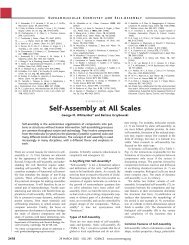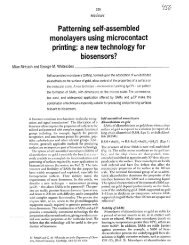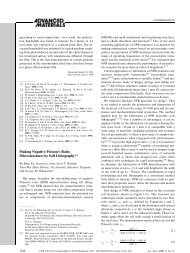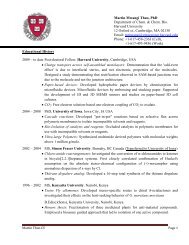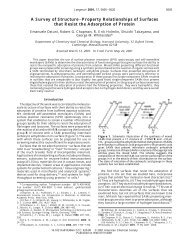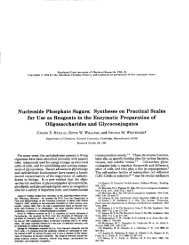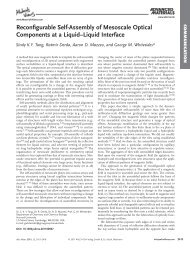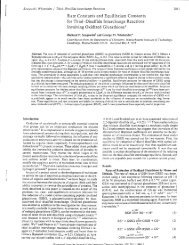Self-Assembled Monolayers of Thiolates on Metals as - Whitesides ...
Self-Assembled Monolayers of Thiolates on Metals as - Whitesides ...
Self-Assembled Monolayers of Thiolates on Metals as - Whitesides ...
You also want an ePaper? Increase the reach of your titles
YUMPU automatically turns print PDFs into web optimized ePapers that Google loves.
1104 Chemical Reviews, 2005, Vol. 105, No. 4 Love et al.<br />
7. Patterning SAMs In Plane 1133<br />
7.1. Microc<strong>on</strong>tact Printing 1134<br />
7.1.1. Compositi<strong>on</strong> <str<strong>on</strong>g>of</str<strong>on</strong>g> Topographically Patterned<br />
Stamps<br />
1134<br />
7.1.2. Methods for Wetting Stamps with Thiols 1135<br />
7.1.3. Mechanism for Forming SAMs by Printing 1135<br />
7.1.4. Structure <str<strong>on</strong>g>of</str<strong>on</strong>g> SAMs Formed by µCP 1136<br />
7.1.5. Transfer <str<strong>on</strong>g>of</str<strong>on</strong>g> PDMS to the Surface during<br />
Printing<br />
1136<br />
7.1.6. Fabricati<strong>on</strong> <str<strong>on</strong>g>of</str<strong>on</strong>g> Nanostructures by µCP 1136<br />
7.2. Photolithography or Particle Beam<br />
Lithography<br />
1137<br />
7.2.1. Photolithography 1137<br />
7.2.2. E-Beam and X-ray Lithography 1137<br />
7.2.3. Atomic Beam Lithography 1138<br />
7.3. Other Methods for Patterning SAMs 1138<br />
7.3.1. Formati<strong>on</strong> <str<strong>on</strong>g>of</str<strong>on</strong>g> Gradients 1138<br />
7.3.2. Ink-Jet Printing 1138<br />
7.3.3. Topographically Directed Assembly 1138<br />
7.3.4. Orthog<strong>on</strong>al <str<strong>on</strong>g>Self</str<strong>on</strong>g>-Assembly 1139<br />
8. Applicati<strong>on</strong>s <str<strong>on</strong>g>of</str<strong>on</strong>g> SAMs <strong>on</strong> Thin Metal Films 1139<br />
8.1. SAMs <strong>as</strong> Etch Resists 1139<br />
8.2. SAMs <strong>as</strong> Barriers to Electr<strong>on</strong> Transport 1139<br />
8.2.1. SAMs for Electrochemistry 1140<br />
8.2.2. SAMs in Organic/Molecular Electr<strong>on</strong>ics 1141<br />
8.3. SAMs <strong>as</strong> Substrates for Crystallizati<strong>on</strong> 1143<br />
8.3.1. Oriented Nucleati<strong>on</strong> <str<strong>on</strong>g>of</str<strong>on</strong>g> Crystals 1143<br />
8.3.2. Alignment <str<strong>on</strong>g>of</str<strong>on</strong>g> Liquid Crystals 1145<br />
8.4. SAMs for Biochemistry and Biology 1145<br />
8.4.1. Designing SAMs To Be Model Biological<br />
Surfaces<br />
1146<br />
8.4.2. SAMs for Cell Biology 1147<br />
8.4.3. Structure−Property C<strong>on</strong>siderati<strong>on</strong>s for<br />
SAMs Used in Biology<br />
1148<br />
9. Applicati<strong>on</strong>s <str<strong>on</strong>g>of</str<strong>on</strong>g> SAMs <strong>on</strong> Nanostructures 1150<br />
9.1. Electrodeposited Metal Rods 1150<br />
9.2. Gold Nanopores <strong>as</strong> Selective Channels 1151<br />
9.3. Arrays <str<strong>on</strong>g>of</str<strong>on</strong>g> Metallic Nanostructures 1151<br />
9.3.1. Arrays <str<strong>on</strong>g>of</str<strong>on</strong>g> Gold Dots 1151<br />
9.3.2. Silver Tetrahedr<strong>on</strong>s for Localized Surface<br />
Pl<strong>as</strong>m<strong>on</strong> Res<strong>on</strong>ance (LSPR)<br />
1152<br />
9.4. Metallic Shells 1152<br />
9.4.1. Metallic Half-Shells 1152<br />
9.4.2. Gold−Silica Core−Shell Particles 1153<br />
9.5. Metal Nanoparticles and Quantized<br />
Double-Layer Charging<br />
1153<br />
9.6. Functi<strong>on</strong>al Surfaces <strong>on</strong> Nanoparticles 1154<br />
9.6.1. Biocompatible Surfaces <strong>on</strong> Quantum Dots 1154<br />
9.6.2. Functi<strong>on</strong>alized Magnetic Nanoparticles 1154<br />
9.6.3. Nanoparticles for the Polyvalent Display<br />
<str<strong>on</strong>g>of</str<strong>on</strong>g> Ligands<br />
1154<br />
10. Challenges and Opportunities for SAMs 1155<br />
10.1. Rules for “Designing” Surfaces 1156<br />
10.2. New Methods for Characterizing SAMs 1156<br />
10.3. New Systems <str<strong>on</strong>g>of</str<strong>on</strong>g> SAMs 1156<br />
10.4. SAMs with Different Physical Properties 1156<br />
10.5. In-Plane Patterning 1156<br />
11. Outlook and C<strong>on</strong>clusi<strong>on</strong>s 1157<br />
12. Acknowledgments 1157<br />
13. References 1157<br />
J. Christopher Love received his B.S. degree in Chemistry from the<br />
University <str<strong>on</strong>g>of</str<strong>on</strong>g> Virginia in 1999 and Ph.D. degree from Harvard University<br />
in 2004. Under the directi<strong>on</strong> <str<strong>on</strong>g>of</str<strong>on</strong>g> Pr<str<strong>on</strong>g>of</str<strong>on</strong>g>essor George M. <strong>Whitesides</strong>, his<br />
doctoral thesis included studies <strong>on</strong> the surface chemistry <str<strong>on</strong>g>of</str<strong>on</strong>g> thiols <strong>on</strong><br />
palladium and fabricati<strong>on</strong> <str<strong>on</strong>g>of</str<strong>on</strong>g> magnetic micro- and nanostructures. He<br />
currently is a postdoctoral research fellow in Hidde L. Ploegh’s laboratory<br />
at Harvard Medical School. His present research interests include<br />
nanotechnology, surface chemistry, self-<strong>as</strong>sembly, micr<str<strong>on</strong>g>of</str<strong>on</strong>g>abricati<strong>on</strong>, immunology,<br />
and cell biology.<br />
Lara A. Estr<str<strong>on</strong>g>of</str<strong>on</strong>g>f is currently an NIH postdoctoral fellow in Pr<str<strong>on</strong>g>of</str<strong>on</strong>g>essor George<br />
M. <strong>Whitesides</strong>’ laboratory at Harvard University working <strong>on</strong> understanding<br />
multivalency in the immune system. In 2003 she received her Ph.D. degree<br />
from Yale University for work d<strong>on</strong>e in Pr<str<strong>on</strong>g>of</str<strong>on</strong>g>essor Andrew D. Hamilt<strong>on</strong>’s<br />
laboratory <strong>on</strong> the design and synthesis <str<strong>on</strong>g>of</str<strong>on</strong>g> organic superstructures to c<strong>on</strong>trol<br />
the growth <str<strong>on</strong>g>of</str<strong>on</strong>g> inorganic crystals. As part <str<strong>on</strong>g>of</str<strong>on</strong>g> her graduate work, Lara spent<br />
time at the Weizmann Institute for Science (Rehovot, Israel) working in<br />
the labs <str<strong>on</strong>g>of</str<strong>on</strong>g> Pr<str<strong>on</strong>g>of</str<strong>on</strong>g>essors Lia Addadi and Steve Weiner. Before that she<br />
received her B.A. degree in Chemistry from Swarthmore College, where<br />
she worked in Pr<str<strong>on</strong>g>of</str<strong>on</strong>g>essor Robert S. Paley’s laboratory.<br />
1. Introducti<strong>on</strong><br />
1.1. What Is Nanoscience?<br />
Nanoscience includes the study <str<strong>on</strong>g>of</str<strong>on</strong>g> objects and<br />
systems in which at le<strong>as</strong>t <strong>on</strong>e dimensi<strong>on</strong> is<br />
1-100 nm. The objects studied in this range <str<strong>on</strong>g>of</str<strong>on</strong>g> sizes<br />
are larger than atoms and small molecules but<br />
smaller than the structures typically produced for use<br />
in microtechnologies (e.g., microelectr<strong>on</strong>ics, phot<strong>on</strong>ics,<br />
MEMS, and micr<str<strong>on</strong>g>of</str<strong>on</strong>g>luidics) by fabricati<strong>on</strong> methods<br />
such <strong>as</strong> photolithography. The dimensi<strong>on</strong>s <str<strong>on</strong>g>of</str<strong>on</strong>g> these<br />
systems are <str<strong>on</strong>g>of</str<strong>on</strong>g>ten equal to, or smaller than, the<br />
characteristic length scales that define the physical<br />
properties <str<strong>on</strong>g>of</str<strong>on</strong>g> materials. At these sizes, nanosystems<br />
can exhibit interesting and useful physical behaviors<br />
b<strong>as</strong>ed <strong>on</strong> quantum phenomena (electr<strong>on</strong> c<strong>on</strong>finement,<br />
1 near-field optical effects, 2 quantum entangle-




